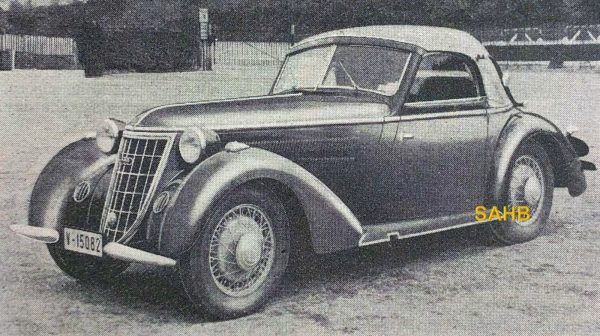
In October 1936 a new car came to Britain and was displayed at that year’s Olympia Show on the Auto Union stand: the Wanderer W25K.
Wanderer was established as Winklhofer & Jaenicke in 1896 by Johann Baptist Winklhofer and Richard Adolf Jaenicke. The company built motorcycles from 1902 and cars from 1903. The Wanderer brand was chosen in 1911 for overseas exports and was soon adopted for domestic sales.
During the Great Depression in 1929, the company owner, Dresdner Bank, sold the motorcycle business to František Janeček, and in 1932 sold the car division at Siegmar to Auto Union, established in 1932 as the umbrella firm for four constituent brands (Audi, Horch, DKW and Wanderer) in a necessary move to face the desperate economic conditions. The four rings of Auto Union are naturally still to be seen today on all Audi cars. Horch was positioned as a luxury brand and DKW as the maker of cheaper cars, and Audi and Wanderer were aimed at the middle market. Wanderer cars were always admired for their high quality and sporting character.
The W25K in our Snapshot had both of these qualities. Most pictures seen nowadays of this fine sports car are of the more exotic roadster, with its swooping low-cut doors and, as far as we can see, no hood (except for a vestigial ‘tonneau’ that could be clipped to the top of the windscreen; if the car could be driven in this way it must have been most uncomfortable). The car at the Olympia Show was instead the arguably far more elegant cabriolet, with full-height doors and a proper hood.
The Wanderer was brought out as a competitor to the BMW 328 introduced in that same year. Wanting a share of this potentially lucrative market, Wanderer turned to Ferdinand Porsche to design a sports car. He did not disappoint: the Wanderer was powered by a very cleanly-designed supercharged six-cylinder engine (hence the K in the name, for Kompressor) of 1,949cc, with a silumin light-alloy cylinder head and upper crankcase, detachable liners and a seven-bearing crankshaft. Overhead valves were operated by pushrods, giving almost identical output to the BMW (85bhp) without the complexity of the 328’s valve gear. The four-speed gearbox had synchromesh on second and third gears. Tests at Brooklands on an admittedly brand-new car, hardly run in, showed a top speed of 83mph against the factory’s claim of 90mph.
The Wanderer’s supercharger gave it a certain marketing appeal – but the car was far more than a ‘cooking’ machine with a blower tacked on. Porsche’s design included a tubular steel chassis with independent suspension all round and hydraulic brakes.
During World War II, all civilian Wanderer production was replaced in 1941 with licence-built military vehicles, such as the Steyr 1500A light truck. The Wanderer plant was destroyed in early 1945, ending the manufacture of Wanderer vehicles.
Photo courtesy of The Richard Roberts Archive: www.richardrobertsarchive.org.uk







Leave a Comment